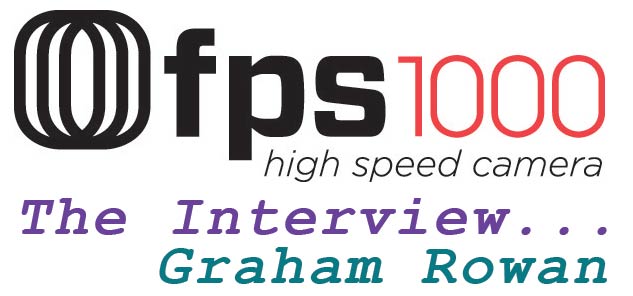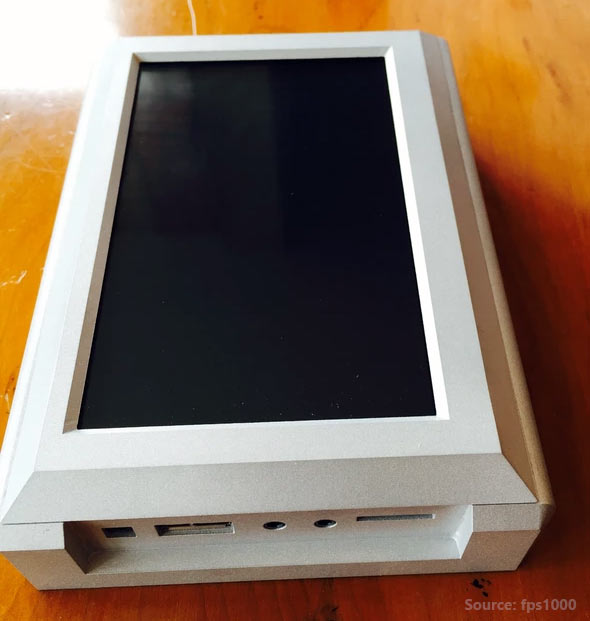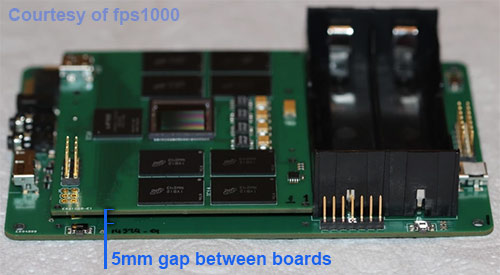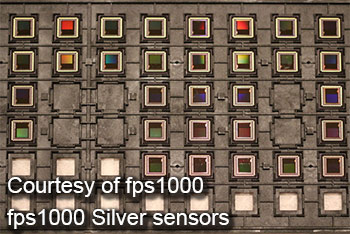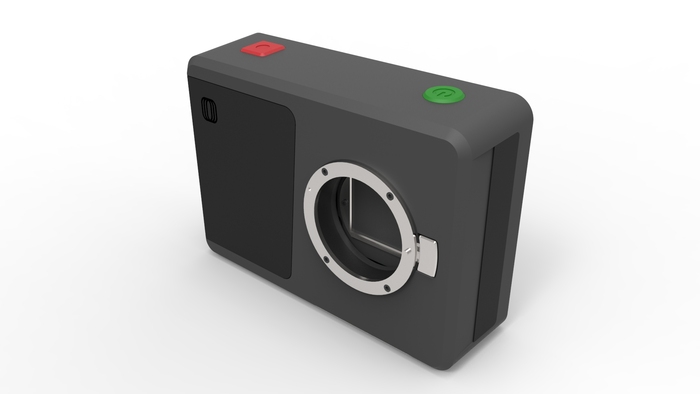Warning: The parent company of FPS cameras “The Slow Motion Camera Company Ltd.” went out of business and entered liquidation proceedings. No further development of cameras is expected. More information here on Google Search!
The creator of the fps1000 camera Graham Rowan carved out some time to answer a few questions posed by our readers and us about the upcoming camera release and what went into the development. The answers are thorough and paint a good image of what the process from idea to build has been like; along with pitfalls and industry insights. The interview is a bit long so grab a donut plus coffee and dig in!
1) HSC: Tell us about your past technical background and why you felt ready to embark on the fps1000 project?
GR: I’ve always been interested in electronics. As a youngster I always had a project on the go. When I got to university I started an Electronics Engineering course, which seemed the obvious choice and it was there that I caught the computer bug! Writing software was an amazing experience for me. I converted my degree into a joint Electronic Engineering and Computer Science degree. For my third year project I developed an interactive circuit building system – a precursor to modern day schematic capture. It was implemented on a PDP 11 with a calligraphic display – before the era of bitmapped displays. This was where I started my long lasting love of graphics displays. From there I spent some time at Logica Research Group playing with the new era of bitmapped displays and image compositing hardware. It was a small jump from there to start up my own company developing hardware and software for the graphics industry. In those days I concentrated on generating images, but the concept was always the same – using new technology to drive down costs and combining hardware and software to make things cheaper, more powerful and programmable. The 1980’s saw the birth of the PC and the rise of 3D graphics boards. The high speed camera market is now in a similar situation. The technical challenges are just as appealing as in those early days and I believe the market is about to explode. These are very exciting times.
2) HSC: Has Kickstarter in your view been the important bridge needed to complete the project or could have been done some other way with the same success. Would you encourage others to use Kickstarter to promote their projects and ideas?
GR: Kickstarter has been instrumental in allowing me to bring this product to market. When I first started out in business things were very much harder. The first stages were the same: come up with a brilliant idea; do your due diligence in deciding on whether it was a marketable product; design and develop a working prototype. Thus far both routes are the same. But then I would have to build a few of the finished product, sell them to early adopters, which would bring in funds to build a few more. In this way the costs were always high, building a handful at a time, and the adoption rate was very slow. With kickstarter this process is reversed. If you are able to get the interest and enough early adopters you can get funds instantly to build a reasonably large quantity and have a ready made market. Of course if the idea flops then you’ve saved a lot of wasted time and money! With the extremely high cost of entry for new products today and a highly competitive marketplace the risks are too high to manage things the old way. Kickstarter is an amazing business model. But it’s so much more than this. Kickstarter is a real community of supporters and backers. Kickstarter has given me access to such a wide range of backers that the product has evolved in a very short time into something that is many times more desirable than the initial idea. And this has benefits for backers who have been able to guide the development.
3) HSC: At this stage have you learned things on this project that could have been done differently or more efficiently?
GR: Product development is always an iterative process. Even the big players get things wrong – I can remember the problems with the iPhone 4 which kept loosing signal if you held it in the wrong way. But the feedback loop is tight and development is fast. I could definitely have been more efficient in getting where I am now but I know that’s how I work. I always do things the long way but work twice as hard to compensate!
4) HSC: The fps1000 is a very ambitious project what have you done to simplify and streamline the complexity?
GR: Without wanting to sound smug I think the fps1000 is as streamlined as it could be! I always look for the simple solution – I’m a strong believer in Occam’s Razor – never make something any more complicated than it needs to be. I have spent many hours thinking and re-thinking of possible solutions during the design process before deciding on a final solution. This is where some of the time has been spent since the success of the campaign. I knew I had to make some changes to the original design – the case, the batteries and a modular design to accommodate future upgrades. I’m very pleased with the final design, which is very simple but very powerful and flexible.
5) HSC: Do you think the fps1000 would have been possible in this price range without the advancements in portable electronics like Phones and tablets?
GR: The fps1000 is in that “sweet spot” that I look for in choosing a product to design. It has to be something that is currently expensive because the technology has to be leading edge – in terms of speed and packaging. Then there has to be some new emergent technology that I can see a way of using to reduce this complexity or speed or size. Memory has always been a key driver in this regard. When I used to make real time 3D displays it was always memory speed and density that were the drivers. If there is a novel way of using this technology in a way that maybe wasn’t originally intended then this is even better. The flash memory used in the fps1000 is just such a technology. One of the main limiting factors with current high speed cameras is the extremely short recording time of a few seconds into very high speed memory. This was due to the use of relatively low density and power-hungry DRAM. Flash memory was very much denser and getting faster and I felt that there might be a way to use it. I was aware of possible limitations such as wear after many write cycles but I kept on looking at different configurations and memory types until I came up with a solution. So yes, without the huge advances in flash memory driven by portable devices this would not have been possible. The other key technology is Li-ion batteries – the fps1000 still requires a lot of power to operate.
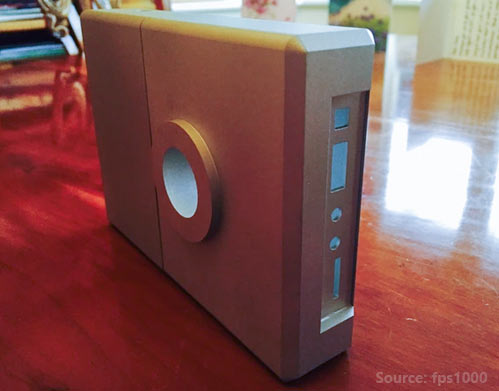
6) HSC: You will be joining an emerging market in high speed products that shoot in HD at lower prices, do you feel the fps1000 is somewhat future-proof compared to recent cameras like the Sony RX10 II and RX100 IV just released that show imaging artifacts?
GR: My aim is always to be at the leading edge of the market in terms of performance. I am only interested in true high frame rates – no cheats, artifacts of compression or skipped frames. Commercial products will always need to make compromises to appeal to the masses and keep the prices down. I know how hard it is to produce equipment that can handle 50 Gbits/sec plus data rates so while the market will become more and more competitive, the fps1000 will always be addressing the highest performance market. The design is also very flexible and can accommodate upgrades with very little effort. I have shown some of the potential with the upgrades that I am offering. There is a lot more to come.
7) HSC: To the budget consumer out there why is the fps1000 a better choice to other affordable high speed cameras feature wise?
GR: The fps1000 offers the best price-performance available today where true high frame rate is required without compromises on resolution or image quality. It also has a very powerful processor on board which I intend to exploit in offering advanced features with regular software upgrades. It all depends on what your priorities are – for casual use where frame rates are not crucial and compressed images are acceptable then there may be cheaper cameras.
8) HSC: We have had a few direct emails on the pricing of the British pound vs the US dollar and how that is a barrier of entry to some potential customers of the fps1000. Do you plan to distribute the fps1000 in America at some point in US Dollars?
GR: I seem to have timed things very badly in this respect! During the campaign the pound was strong which affected backers. Now that I’m buying components, many of which come from the US, the pound is weak which is really hurting me!
I am open to discussions on overseas distribution. I have already been approached by some distributors, but it is too early to put anything in place just yet. As volumes ramp up there are a lot of potential savings in cost to be made.
9) HSC: What kind of software features can fps1000 owners and interested potential customers expect at shipping date and what could be done at a later date? i.e. Peaking, Histogram, Basic File Erase/Trim.
GR: There will be a very basic set of facilities at first shipment date – I will want to get cameras to backers as soon as possible. However, the camera already has the essential features that are needed. Obviously, record and playback in camera with nice gesture-controlled forward and backward scrolling to find and edit a clip and save to disk. Plus a couple of focus aids such as peaking and a couple of others that I’m keeping secret for now! I also want to remind people that I am opening up the camera for user-programming and want to make the software platform open for enhancement. The architecture has some very fast pathways which can be exploited in many ways.
10) HSC: The edgertronic camera released in 2014 has been gaining ground, what are your thoughts on this camera and it’s features?
GR: I have a lot of respect for Mike and the edgertronic since its launch on kickstarter. I remember seeing it while I was in the process of designing the fps1000. I like the fact that he set his goal, to produce a high speed camera that went head to head with the expensive cams out there at a reasonably low cost. His approach was conservative: established high speed sensor; high speed DRAM with several seconds of memory and a remote Ethernet link. He wasn’t trying to produce a consumer camera and he was only addressing the US market, which he understood. He’d clearly thought his design through and was ready to mass produce. And I remember he hit his promised delivery date. It wasn’t ground breaking technology but it did the job. There is room in this market for his approach as well as mine. I wish him continued success.
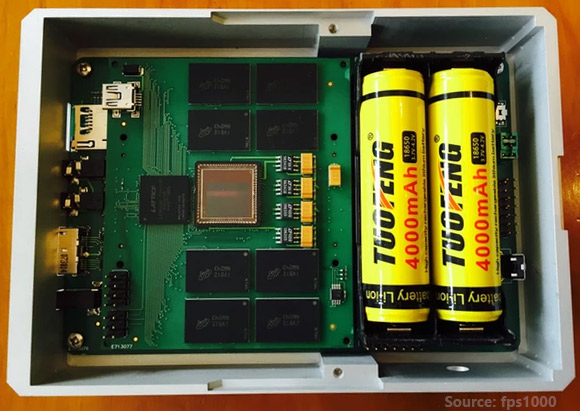
11) HSC: The latest Sony Stacked Sensor technology for CMOS seems to help with the global shutter problem by permitting a 1/32,000 electronic shutter with some artifact correction for distortions. Do you think this opens the way to better performing lower cost and higher ISO/lower noise high speed cameras?
GR: I think innovations in sensor technology will be an important factor in future. One of the problems I face is the need to use off-the-shelf sensors with the manufacturer’s set of compromises baked in. Ideally I’d love to design my own sensor. You can see the benefit of this with Black Magic’s recent cameras which now use their own sensor rather than the CMOSIS one with its poor low light capability. Backlit sensors have much better light sensitivity. Also, being able to potentially build memory close to the sensor reduces some of the bandwidth requirements. Unfortunately, to make a custom sensor requires millions of dollars of investment. Maybe an idea for a future kickstarter?
12) HSC: Have you narrowed down the imaging format that the fps1000 will use? There seems to be a lot of interest in codecs and or RAW sequences supported.
GR: The fps1000 shoots naturally in RAW format which is the most important thing for most users. The files are stored in camera as a series of still images that can be easily imported into a post-production system. There is also an option to compress the video in camera using H.264 in a .mov wrapper. I will implement other formats as customers require.
13) HSC: Do you expect to see fps1000 cameras shipped to initial buyers this year as expected?
GR: Most definitely. I am getting very close to initial shipments. The 4K is following closely behind. I see huge possibilities for this market. I have been working long hours daily since the campaign launch and will continue to do so until all orders are shipped. I am as enthusiastic as I was at the beginning.
14) HSC: What does the fps1000 do in hardware that can permit such a low price compared to similar spec high speed cameras that cost several orders of magnitude more?
GR: The key to the design is simply the smart use of memory and programmable logic rather than brute force. The other main factor is that it is priced to make it available to a wide customer base. When the market is small and specialised I guess it is possible to make large margins. I think this market is about to explode and I want to be a player. My main aim is not making a lot of money – yes, enough to make the business viable – but to be a major player in an exciting new market.
15) HSC: Have the days of extremely expensive high speed cameras nearing an end?
GR: I think that’s inevitable. You can see the rapidity with which new high speed cameras are being introduced. It is a market that is gaining momentum. It has happened so many times before – once a market gains a sufficiently high profile, development dollars are thrown at it and the technology development accelerates. It’s too late to stop it now. All the market players need to re-adjust and either innovate and reduce their own costs or find new markets.
16) HSC: It seems technology is advancing so fast and miniaturization so compact these days that an over 1000fps camera in a phone could be possible very soon. Mediatek has a 480fps capable SoC in the Helios X10 and X20 in full HD 1080p. All of the demo videos on this portable tech do seem to show aliasing artifacts is this because the hardware is flawed?
GR: To get these frame rates within the constraints of a mobile phone, there are compromises that need to be taken. This is where products such as the fps1000 differentiate themselves – my goal is to achieve true high frame rates without compromise. The phone companies are trying to tick boxes and don’t mind taking a few short cuts to do so. I’m after sheer performance and will always keep ahead of the commodity market. The phone format is also not ideal for the camera market. The two markets will co-exist and we will all benefit from the development of low power, high performance components that will have to be developed for the phone market.
17) HSC: Have orders after the fps1000 Kickstarter campaign exceeded your expectations?
GR: Most certainly yes! I had no real ambitions of huge orders at the start – I just thought it would be cool to do. The support and feedback I’ve had has been amazing. It seems to have struck a chord with the community.
18) HSC: Have you received any calls from established high speed companies downplaying the fps1000 project?
GR: Not at all. On the contrary, I’ve had large players interested in partnering to give them access to the larger market or to fill gaps in their range that they can’t or don’t want to fill. Any serious player in this market won’t dismiss smaller competitors – the smart ones will want to embrace the changing market. After all, their reputation isn’t going to disappear overnight but they will want to take notice of what’s happening around them and adjust their strategy to suit.
19) HSC: When new groundbreaking tech is released it’s usually dismissed as something not needed or flawed in some way by proponents of similar products, the fps1000 seems a disruptive product that could alter the camera market forever; do you feel it will?
GR: I hope so. I like changing the rules. I know it has the potential to change people’s way of thinking – even if only from the point of view of price / performance. Even if it has a relatively short lifespan I think it has already helped to accelerate the rate of change in this exciting market.
20) HSC: If you could start the project all over again what would you do different the second time around?
GR: Nothing! That may sound arrogant but it’s not meant to. I’ve made many mistakes along the way and with 20/20 hindsight, sure I can think of many ways I could have improved the process. But then I wouldn’t have gained the knowledge and experience that I have. I don’t believe in looking back – I always focus on the next step.
21) HSC: The fps1000 seems small and lite enough to be mounted into drones especially due to the small power required. Do you feel it could be the high speed camera of choice for quad copter flyers?
GR: Why not? For specific applications such as that you can always change the packaging to suit the market better. The core technology would certainly be very suitable. But I would want to customize the design to concentrate on size, weight and cost. If anybody wants a custom design for specific markets then I’m happy to help in this area.
22) HSC: The HDMI port had to be scrapped from the redesign of the camera due to time constraints, will there be a way to monitor the image aside from the built in screen?**
GR: As you will know by now I have given in to popular request and re-instated the HDMI output! I agree, it is essential. I’ve re-thought the storage too and managed to incorporate a CFast 2 card slot to cater for high speed image retrieval from the camera.
**HSC: The interview was submitted before the new feature changes were announced!
23) HSC: In one of the fps1000 project updates the sensors used in the cameras have been improved by the manufacturers. What kind of sensitivity improvements have you seen from the improved designs?
GR: This is an example of how quickly technology moves. When I first designed the camera I chose a manufacturer that was at the leading edge and I knew there were developments in the pipeline. By the time the fps1000 came to market there were new sensors available that I could easily slot in. This gave me improvements of about 30% in sensitivity. As a result of the campaign I have also been contacted by another major sensor supplier which has been instrumental in enabling some of the upgrades that I am offering.
24) HSC: We know that the case has been a difficult part of the project to get ready, can you share some info on progress and or pitfalls of building a camera case?
GR: Yes, the camera case was really outside of my comfort zone. It’s something that I’d never been involved in – all of the products I’d developed previously were board-level or OEM products. It’s been quite a learning curve for me trying to get to grips with the different materials and manufacturing methods that are available. I’ve also not helped the process by being very fussy about making it look professional. I didn’t want it to look hacked together. But it’s been a shock to find out how much it costs to build. I am also very aware of lead-times and didn’t want to get into long development and tooling cycles. But I’m finally getting to a point where I’m happy with the solution I’ve found. In future I’ll be much more aware of this process and will think about packaging from the outset.
25) HSC: Will the case be sealed in a way that it could withstand minor moisture or light rain?
GR: The case is machined with interlocking body and top and should be pretty air tight. It’s not designed to be water resistant but should be able to handle light rain. I think this is something that I will continue to improve. I have been contacted by companies specializing in waterproof casings so expect to see a waterproof fps1000 on the market in the near future.
26) HSC: How supportive have been backers after the project was funded concerning delays and re-designs due to improvements and Kickstarter goals?
GR: 100%. I have been amazed at how supportive and patient everyone has been. I think most backers understand what they’re getting into when they invest in a product – I have been on this side of the fence with many projects that I have supported. I think the main thing is to be totally transparent with everyone and to keep them informed. I have tried to respond to questions very quickly and to be pro-active about informing people of progress. This takes a considerable amount of time but is necessary to keep everyone’s support. This truly is a unique environment where new technology can emerge.
27) HSC: Will the camera record sound along with the imagery by the use of some I/O port to connect a microphone?
GR: I’ve not yet worked out the importance of sound in slow motion. They don’t seem to fit together well. I’m happy to be guided if this is something that people want to do.
28) HSC: Not everyone with the technical know how to build such a camera would embark in a project like the fps1000; what made you create and bring about the fps1000?
GR: Stupidity! I’ve always gone for ambitious goals. It seemed like a great technical challenge and a really cool product. It certainly wasn’t as a result of market surveys and it wasn’t profit driven. It just seemed like the right product. I’m really glad I did it.
29) HSC: Are inventors like yourself an integral part of forcing technology forward in price and adoption? Or should we leave it to large established companies?
GR: Well I’m pretty biased but most certainly yes! Good ideas are accessible to everyone – not just large companies with money to spend. And the tools and facilities are available today to enable anyone to participate. Kickstarter is a prime example of this. It’s relatively easy for anyone to produce a product and news travels instantaneously today so where marketing used to require large budgets, this is no longer an obstacle. I have always found that small companies provide the innovative driving force for new markets. It is becoming more common today for large companies to progress and stay in the market by acquiring small companies with new ideas.
30) HSC: If a future inventor is reading this interview, what words of advice and wisdom would you share?
GR: Just do it! Don’t be afraid of exposing yourself and your idea to the public. People are very prepared to listen and help and back you. If your idea is lacking in some way they will help you to improve it. At worst you won’t reach your target but you will come away very much more experienced for it. I don’t think you will find any negativity – at worst just constructive criticism and good wishes. If you are out to abuse the system (and I have seen very few examples of this) then expect to be shot down in flames!
31) HSC: In a poll a few years back in the UK there was a popular vote between Shakespeare and Newton as the most important mind of the millennium. Newton lost with less than 35% of the vote. Who would you pick and why?
GR: Well of course both have had a huge influence on generations following them. The most exciting and important thing for me is to learn and make some sense of the universe we live in. Newton is a hero of mine, alongside Einstein. They were great minds that worked on thought experiments and posed important questions about the things we witness every day. I took a Masters in Astrophysics a couple of years ago to give me a foundation to base questions of my own. I’d love to create products that help us discover more about us, and our surroundings.
HSC: We would like to thank Graham Rowan for the time spent away from the fps1000 project and his spare time in order to provide the answers for this interview. Thanks For Reading!
More information about the fps1000 or how to order one follow the project on Kickstarter!
Interview performed by James Benet – © hispeedcams.com 2015 Please contact us if you intend to republish, reprint or share this interview on your website.

